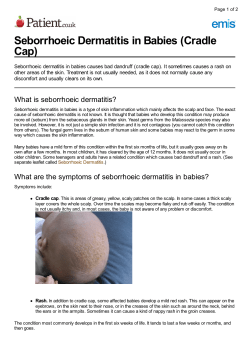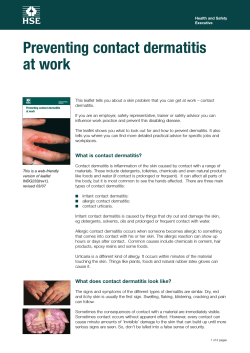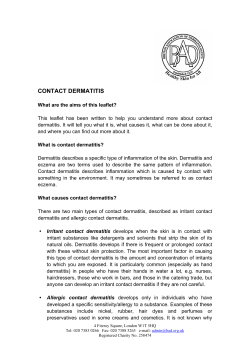
The causes of adult scaly scalp conditions
The causes of adult scaly scalp conditions Forum Dermatology Presentation of a scaly scalp can be due to more than one condition, so getting the diagnosis right is essential, writes Johnny Loughnane Figure 1. Psoriasis of the occiput with well-defined edge and thick, silvery scales Figure 2. Seborrhoeic dermatitis of the scalp with finer, dandruff-like scaling. Note alopecia secondary to scalp inflammation In adults presenting with a scaly scalp, the diagnosis is usually between seborrhoeic dermatitis and psoriasis. Nowadays, we also need to know that fungal infection with trichophyton tonsurans may present with a diffuse scaly scalp, not unlike seborrhoeic dermatitis. This has been documented especially in Dublin, among immigrant communities. It is important, as unlike other scalp fungal infections, it easily spreads from scalp to scalp. The hair covering the scalp makes the skin fairly inaccessible and makes diagnosis and treatment difficult. A full skin examination is necessary to help differentiate between seborrhoeic dermatitis (forehead, eyebrows, ears, nasolabial folds, presternal area and flexures) and psoriasis (knees, elbows, sacral area and nails). Seborrhoeic dermatitis The diagnosis of seborrhoeic dermatitis is based on clinical presentation. A fairly well-demarcated, erythematous rash, covered by greasy looking scales on the forehead, eyebrows, ears, nasolabial folds, presternal area and flexures is found. It is a chronic condition with a relapsing and remitting course. The extent of erythema and scaling varies widely and often the findings are very subtle. Sometimes scale is thick and adheres to the hair shaft, appearing to climb up the shaft, known as pityriasis amiantacea. The name seborrhoeic dermatitis suggests seborrhoea – an increased production of sebum, but the majority of patients have normal sebum production. The role of sebum in the pathogenesis of seborrhoeic dermatitis is not clear. It is best to consider it a dermatitis of the sebum-producing areas of the body, as outlined above. Adult seborrhoeic dermatitis most commonly presents between the ages of 18 and 45 years. The fungus Malassezia furfur (previously called Pityrosporum ovale) has a role in the pathogenesis of seborrhoeic dermatitis. It colonises most skin but is found in greater concentration in areas of active seborrhoeic dermatitis. The inflammatory component of the dermatitis may reflect a toxic or allergic reaction to Malassezia furfur. The precise mechanism by which it causes or exacerbates seborrhoeic dermatitis however, has not been defined. Presentation Seborrhoeic dermatitis of the scalp presents with scaling and erythema. Itch may be the only symptom and is usually mild. Dandruff, ie. diffuse, fine, powdery white scale on the scalp, represents the mildest form of disease. The extent of inflammation is variable, from none at all to being severe enough to cause temporary alopecia. Look for evidence of disease in other areas. External ear canal and post-auricular fold involvement may present with fissuring, oozing and secondary bacterial infection. The central forehead, eyebrows, eyelids and naso-labial folds are frequently involved. Males often have a patch over their sternum. Initial treatment aims to control the acute episode. Once under control, remission needs to be maintained. Good FORUM April 2009 57 13. Dermatology/SS/NH2* 1 26/03/2009 11:30:06 Forum Dermatology hygiene with regular washing using an antifungal shampoo is important to reduce the risk of recurrence. Always advise patients that this is a chronic condition which we cannot cure and they must expect either intermittent or long-term treatment. The acute episode Mild Anti-dandruff shampoo, eg. zinc pyrithionne (Head and Shoulders), coal tar (T Gel, Exorex, Capasal), selenium sulphide (Selsun). More severe Ciclopiroxolamine shampoo (Stieprox) twice-weekly or ketoconazole shampoo (Nizoral) twice weekly. Results are better if the shampoo is applied to the scalp and left there for a few hours, before washing out. If inflammation is more severe Add topical steroids for two weeks, eg. betamethasone (Betacap, Betnovate, Bettamousse). For hair margins use less potent steroid - clobetasone (Eumovate). If scale is more severe Need to use a descaling agent, eg. Cocois scalp application (needs to be left on longer than advised on patient information sheet supplied with product). Cocois scalp application can be left on overnight, under a shower cap, and washed out in the morning with a tar shampoo. If scale is thick Salicylic acid 2-10% (depending on thickness) in yellow soft paraffin, applied overnight, and washed out with a tar shampoo in the morning is useful. Maintenance treatment Once the acute episode is settled it is important to introduce a maintenance regimen to reduce risk of recurrence. Antifungal shampoo (Head and Shoulders, T Gel, Exorex, Capasal or Selsun) may be used twice weekly. If these are ineffective, Stieprox or Nizoral twice weekly may be tried on a continuing basis. Psoriasis Like seborrhoeic dermatitis, psoriasis is common, affecting 2-3% of the population and presenting with erythematous, scaly, well-demarcated plaques on the scalp, knees, elbows and sacral area. The peak age of onset is late teens to early 20s. Flexures may be involved in inverse-pattern psoriasis. Nail involvement is common. The scalp is involved in up to 80% of cases and may be the initial site of involvement. It is not unusual to have the scalp continuously involved, with patches in other parts of the body coming and going. With severe disease there may be reversible alopecia. Permanent, scarring alopecia is rare. Reduction in quality of life Because of its visibility, scalp psoriasis frequently interferes with daily activities at home, at work and socially. Plaques may advance beyond the hair margin and be visible on the face. Areas of hair loss may be visible. Not surprisingly, significant reduction in quality of life has been confirmed in many studies. We often forget that for many patients psoriasis is quite pruritic. Constant picking and scratching the scalp adds further to social distress. Indeed, damage to the scalp by picking and scratching the skin exacerbates psoriasis, the so-called Koebner phenomenon. Presentation The plaques of psoriasis are very well-demarcated and feel elevated to touch. The scales are white in contrast to the more waxy colour found in seborrhoeic dermatitis. Scratching the plaques makes the scale more prominent – a very useful sign when trying to make a diagnosis. The elevated plaques on the scalp are often more apparent if one feels with all one’s fingers through the patient’s hair. Because of its physical and psychosocial adverse effects, it is important to have an acceptable and effective treatment. Most treatments that are effective are messy to apply. Compliance with unacceptable treatments is poor. Essentially treatment needs to: • Remove scale • Settle inflammation • Relieve itch. Very thick scale must be removed in the first instance. Other treatments may then better penetrate through to the scalp and be more effective. A 10% salicylic made up in soft paraffin, applied to involved areas and washed out with a tar shampoo in the morning is effective if scale is thick. Tar If scale is less severe, Cocois ointment (coal tar 12%, sulphur 4%, salicylic acid 2%) as for seborrhoeic dermatitis is usually effective and well-tolerated. Calcipotriol Calcipotriol scalp solution has been available for some time. It can be slow to work and thicker scaling must be removed prior to starting it. Topical steroids Steroid lotion at night, betamethasone valerate (Betacap scalp application or Bettamousse) may be used in combination with calcipotriol or tar. A newer steroid preparation (Etrivex) has been available for the past year. Steroids should not be applied continuously for more than a month at a time. Steroids relieve itch and settle the inflammatory component of the disease. After one month tachyphylaxis can be a problem, ie. less and less a response the longer a preparation is used. However, when combined with calcipotriol and tar, steroids improve response. Time to clearance is greatly reduced as is the level of improvement. Topical steroids also reduce any irritating tendency from calcipotriol or tar. Combination treatment Patients find it difficult to adhere to twice-daily applications. A combination scalp product containing calcipotriol and betamethasone (Xamiol) is now available. It is more effective than each of its individual components. It is acceptable and requires only once daily application. This should improve compliance. It is best to apply it at night and wash it out in the morning. Most patients will not require descaling prior to starting this combination. Patients should be advised that when washing it out, they should first apply shampoo to dry hair. This dissolves the application, which can be then washed out. Johnny Loughnane is in practice in Limerick 58 FORUM April 2009 13. Dermatology/SS/NH2* 2 26/03/2009 11:30:21
© Copyright 2025














